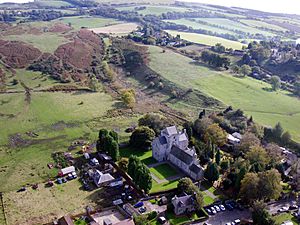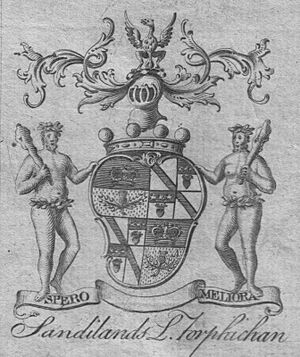Torphichen Preceptory facts for kids
Quick facts for kids Torphichen Preceptory |
|
|---|---|
 |
|
| Lua error in Module:Location_map at line 420: attempt to index field 'wikibase' (a nil value). | |
| Location | Torphichen, West Lothian |
| Country | Scotland |
| Denomination | Catholic |
| Architecture | |
| Years built | 1140s |
Torphichen Preceptory is an old church in the village of Torphichen, West Lothian, Scotland. It was once the main base, or "preceptory," for the Knights Hospitaller of the Order of St John of Jerusalem in Scotland. These were a special group of knights who helped people during the Crusades. The name Torphichen might come from an old Gaelic phrase meaning "St Féichín's boundary" or "sanctuary." This fits well with the ancient stones found around the village.
Contents
The Preceptory Building
The Preceptory was built in the 1140s. It was built around an even older church that might have been there since early Christian times. In the 1200s, the Preceptory became much bigger. The parts of the building you can still see today were first built then.
The complex included a church shaped like a cross. It had a main hall (nave), a central tower, side sections (transepts), and a choir area. The tower and transepts are still standing. There were also other buildings, like a hospital. The church was made even bigger in the 1400s, and a cloister was added. A cloister is a covered walkway, usually around a courtyard. This one was on the north side of the church, which was very unusual for the time.
Changes Over Time
After the Scottish Reformation (a big change in religion in Scotland), the main hall of the Preceptory church became the local parish church. The rest of the buildings slowly fell apart. However, the central part of the church, under the tower, still has some of the best-preserved stonework from the late 1100s and early 1200s in Scotland. It shows amazing architectural details.
In 1756, the main hall and other buildings were taken down. A new church was built in a T-shape. This church still has its original box pews and galleries from the early 1800s. For some years, the remaining parts of the Preceptory were even used as a courthouse. The central tower got a new roof in 1947. Today, Historic Scotland looks after it, and you can visit it in the summer.
Sanctuary Stones and Kirkyard
A special "sanctuary stone" stands in the churchyard (kirkyard). This stone marks the center of an "area of sanctuary" that once stretched for one Scots mile (about 1.8 kilometers) around the church. People who needed protection could find safety within this area. The east and west sanctuary stones are still in their original spots. Some people think these stones are much older than the medieval Preceptory. They might be connected to the important Neolithic (New Stone Age) henge and burial mound at Cairnpapple Hill, which is nearby.
The large churchyard also has many interesting gravestones from the 1600s and 1700s. They show cool "folk art," like symbols of death or tools that represent what people did for a living.
The Knights Hospitaller
The Knights Hospitaller were a military and religious group formed during the Crusades. They were known for helping sick and injured pilgrims. King David I invited them to Scotland in 1132.
After another group, the Knights Templar, were stopped in 1312, their lands were given to the Knights Hospitaller. Torphichen became one of the most important Hospitaller sites in Britain, second only to their main base in London. This transfer of land made Torphichen much richer and more powerful.
Battles and Leaders
In 1298, during the Battle of Falkirk, Alexander de Welles, who was the Master (leader) of Torphichen Preceptory, was killed. He was likely from the Welle(s) family in Lincolnshire, England.
William Wallace, a famous Scottish hero, held his last parliament (a meeting of leaders) here before the Battle of Falkirk in 1298. The only document still existing that Wallace signed as "Guardian of Scotland" was prepared at Torphichen. After the battle, King Edward I of England was brought to the Preceptory. He needed treatment for injuries he got when his horse stepped on him.
The Hospitallers fought on the English side during the Wars of Scottish Independence. They left Scotland after the Scots won the Battle of Bannockburn. However, they returned during the rule of Robert the Bruce.
Sir William Knollys, a later leader of the Preceptory, served as the Lord High Treasurer of Scotland for King James III and King James IV. He was given the title Lord St. John of Torphichen. Many believe he died at the Battle of Flodden in 1513.
End of the Preceptory
The last leader of the Preceptory was Sir James Sandilands. His father and older brother supported the Lords of the Congregation, a group of Scottish nobles who wanted to change the church. They were also friends with John Knox, a key figure in the Scottish Reformation.
In February 1564, Sir James gave the Preceptory lands to the Crown, meaning to his relative, Mary, Queen of Scots. She then gave the lands back to him for a payment of 10,000 crowns. With this, he received the new title of Lord Torphichen.
Today, the special title of Preceptor of Torphichen is still used. It is an honorary position within the modern Order of St John of Jerusalem.
See also



